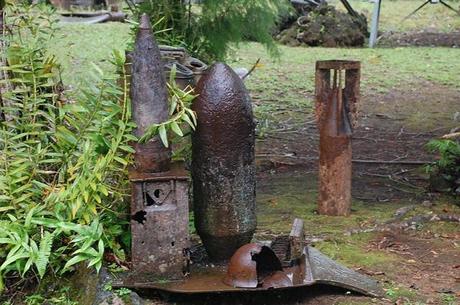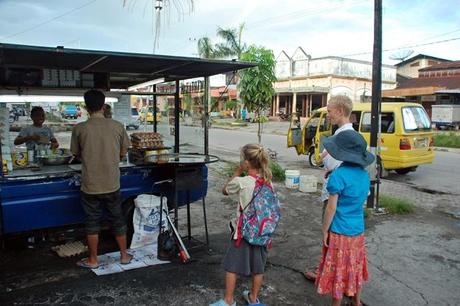We go to the market in the morning look for a ‘bemo’ (the minivan/bus system that operates as public transportation all over Indonesia). The public market is a de facto bus terminal, and we’re quickly able to secure a car and driver for the day. It’s nice to be in a country where this is readily affordable- split between three boats, it’s downright cheap- we’ll end up spending about $10 each for our day of being driven around.
Our first stop is a large cave where thousands of Japanese soldiers hid during World War II.

WWII artifacts are strewn around the grounds of the museum
It eventually became their tomb, when allied forces attacked the site. We’re caught in a squall during our visit, and lightning into the caves adds a spectacularly eerie touch. I decide to wait until after we exit to point out how close the bats were swooping to the children’s heads. Creepy. It’s impossible not to think about the lives that ended here- the cave opens up with a gaping hole above, where allies bombed and killed all within.
The family who has the cave on their land has built a small museum. Spread all around the lawn are bombs (unexploded?!) and shells by the dozen. The shell of an old car rusts next to a stack of equally aged fuel drums- there’s even a partial airplane fuselage.
Inside the closet-sized museum (truly, we can just fit in a few bodies and turn around) is an astonishing collection of artifacts. Everything from belt buckles to award medals, knives, guns, watches, glass ampoules (of what?), and Japanese currency- to a hanging rod of original uniforms. There are even a few swords, the brutal reminder of an execution method of choice.
Niall has become very well informed on WWII, reading everything he can get his hands on since we left Australia. The wrecks in PNG fed his interest, but these small relics are entirely different category than what we’ve seen to date. He’s so excited, he runs around photographing it all for memory- that's one of his photos above.
The skies clear somewhat, and we head out to a bird park. The famous Bird of Paradise is endemic to this area, but tricky to see in the wild- we expect to settle for peek at the caged version.
Unfortunately, the park is closed. What happens next is completely typical. Instead of accepting defeat, our driver says he’s pretty sure the guy with the key is in the village just down the road. I have no idea if he really knows this or is just hoping, but we go trundling off and sure enough- 10 minutes later, we’ve found our keeper. He’s happy to jump on his motorbike and come back to the park to open it up for us.
I should have remembered how depressing zoos can be. The birds are segregated by species, and none of the cages seem quite big enough. They are stunning, to be sure. Ironically, the lone Bird of Paradise is the least interesting of the bunch. It doesn’t’ sport the famous tailfeathers, so really just looks like a fat white pigeon. We’re quickly getting munched by mosquitoes.
We head back into town, and I get a run at the grocery store. Our driver is a huge help. He comes with us, helps carry bags, and helps find things that I can’t locate. It’s the most efficient stock-up in a long time.
In an effort to promote hero status when we get back to the boat, we pick up dinner to bring back. I had found a street vendor selling on my first jaunt into town to track down the harbormaster after our arrival and am pretty sure this will be a slam dunk- and entertaining enough to hold the kids while we wait for them to be prepared.
 Hungry kids are so patient waiting for their martabak treat!
Hungry kids are so patient waiting for their martabak treat!
Martabak is a pastry generally filled with a mixture of eggs, onions, and meat (street vendors usually make just one, but the storefront restaurants offer sweet and savory). The drama comes with the vendor takes his golf-ball sized lump of dough, then flattens and pushes and eventually spins it- picture pizza dough spinning- into a large, whisper thin sheet. It is lowered by one edge into a large flat wok, which the vendor folds as he goes, then pours in the egg-veggie-meat mixture until it’s a rectangular pillow around the savory filling within. Each one is cut into pieces and boxed to go. They are so nuclear, that even when we get to the boat and all collect on Nalukai for a sundowner and our martabak about half an hour later, they’re still very warm to the touch. Little savory pillows of Indonesian heaven- for about $2.50 each. We might have to go back tomorrow…

